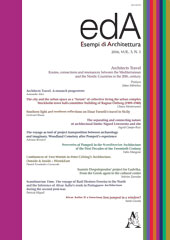Estratto da
ESEMPI DI ARCHITETTURA
International Journal of Architecture and Engineering
The separating and connecting nature of architectural limits:Sigurd Lewerentz and site
ESEMPI DI ARCHITETTURA
International Journal of Architecture and Engineering
The separating and connecting nature of architectural limits:Sigurd Lewerentz and site

This essay aims to evaluate and develop a separating and connecting notion of architectural limits, byassessing Swedish architect Sigurd Lewerentz’s (1885-1975) way of establishing connections with theenvironment and social circumstances through the design of buildings, landscapes and other constructions.I will argue that architectural limits can separate an architectural project from its setting,while also empowering relationships between the users and the site, depending on the way these limitscritically address emerging social demands and respect environmental conditions. I posit that sitein architecture is a critical position from which to understand the world and from which to determinewhich the areas of the world have a significant role in each architectural project. Lewerentz’s projects,notably the Woodland Cemetery (1915-1961) with Gunnar Asplund, and his designs of the churchesof St Mark’s (1956-64) and St Peter’s (1962-66), impacted on subsequent architectural developments inSweden and on international architectural discourse. The examination of Lewerentz’s recently discoveredtravel log to Italy and other documents from his trips to France and the Baltic and their impacton his works play a key role in assessing connections between his projects and their settings. His tripsto Italy and the oncoming projects of the 1920s involved a process whereby Lewerentz establishedsimilarities between his designs and topography or vegetation. From around 1928 onwards, Lewerentz’sexploration of high-quality fenestration systems provided a background for adapting his projectsto the fast-changing urban environment, and critically distancing himself from developments, inwhich construction belittled the role of people. Lewerentz’s later church designs were an effort tobuild public spaces, by enhancing the natural environment, climatic conditions, spiritual dimensionsand freedom. Lewerentz’s works provide a lens through which to examine the potential of architecturallimits as a tool for critically connecting a project with important areas of people’s lives.
| pagine: | 41-52 |
| DOI: | 10.4399/97888548991794 |
| data pubblicazione: | Dicembre 2016 |
| editore: | Aracne |








